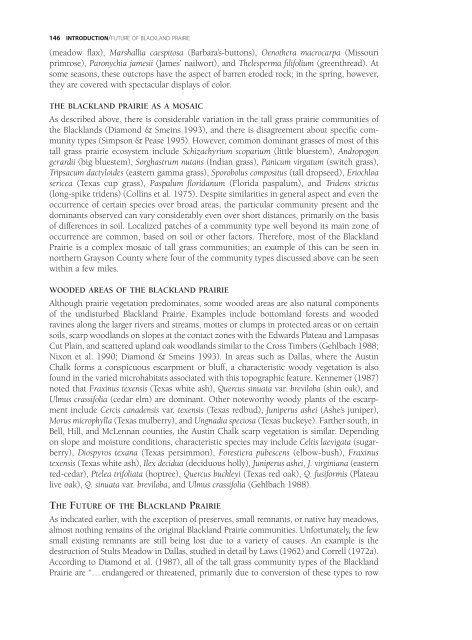ILLUSTRATED FLORA OF EAST TEXAS - Brit - Botanical Research ...
ILLUSTRATED FLORA OF EAST TEXAS - Brit - Botanical Research ...
ILLUSTRATED FLORA OF EAST TEXAS - Brit - Botanical Research ...
You also want an ePaper? Increase the reach of your titles
YUMPU automatically turns print PDFs into web optimized ePapers that Google loves.
146 INTRODUCTION/FUTURE <strong>OF</strong> BLACKLAND PRAIRIE<br />
(meadow flax), Marshallia caespitosa (Barbara’s-buttons), Oenothera macrocarpa (Missouri<br />
primrose), Paronychia jamesii (James’ nailwort), and Thelesperma filifolium (greenthread). At<br />
some seasons, these outcrops have the aspect of barren eroded rock; in the spring, however,<br />
they are covered with spectacular displays of color.<br />
THE BLACKLAND PRAIRIE AS A MOSAIC<br />
As described above, there is considerable variation in the tall grass prairie communities of<br />
the Blacklands (Diamond & Smeins 1993), and there is disagreement about specific community<br />
types (Simpson & Pease 1995). However, common dominant grasses of most of this<br />
tall grass prairie ecosystem include Schizachyrium scoparium (little bluestem), Andropogon<br />
gerardii (big bluestem), Sorghastrum nutans (Indian grass), Panicum virgatum (switch grass),<br />
Tripsacum dactyloides (eastern gamma grass), Sporobolus compositus (tall dropseed), Eriochloa<br />
sericea (Texas cup grass), Paspalum floridanum (Florida paspalum), and Tridens strictus<br />
(long-spike tridens) (Collins et al. 1975). Despite similarities in general aspect and even the<br />
occurrence of certain species over broad areas, the particular community present and the<br />
dominants observed can vary considerably even over short distances, primarily on the basis<br />
of differences in soil. Localized patches of a community type well beyond its main zone of<br />
occurrence are common, based on soil or other factors. Therefore, most of the Blackland<br />
Prairie is a complex mosaic of tall grass communities; an example of this can be seen in<br />
northern Grayson County where four of the community types discussed above can be seen<br />
within a few miles.<br />
WOODED AREAS <strong>OF</strong> THE BLACKLAND PRAIRIE<br />
Although prairie vegetation predominates, some wooded areas are also natural components<br />
of the undisturbed Blackland Prairie. Examples include bottomland forests and wooded<br />
ravines along the larger rivers and streams, mottes or clumps in protected areas or on certain<br />
soils, scarp woodlands on slopes at the contact zones with the Edwards Plateau and Lampasas<br />
Cut Plain, and scattered upland oak woodlands similar to the Cross Timbers (Gehlbach 1988;<br />
Nixon et al. 1990; Diamond & Smeins 1993). In areas such as Dallas, where the Austin<br />
Chalk forms a conspicuous escarpment or bluff, a characteristic woody vegetation is also<br />
found in the varied microhabitats associated with this topographic feature. Kennemer (1987)<br />
noted that Fraxinus texensis (Texas white ash), Quercus sinuata var. breviloba (shin oak), and<br />
Ulmus crassifolia (cedar elm) are dominant. Other noteworthy woody plants of the escarpment<br />
include Cercis canadensis var. texensis (Texas redbud), Juniperus ashei (Ashe’s juniper),<br />
Morus microphylla (Texas mulberry), and Ungnadia speciosa (Texas buckeye). Farther south, in<br />
Bell, Hill, and McLennan counties, the Austin Chalk scarp vegetation is similar. Depending<br />
on slope and moisture conditions, characteristic species may include Celtis laevigata (sugarberry),<br />
Diospyros texana (Texas persimmon), Forestiera pubescens (elbow-bush), Fraxinus<br />
texensis (Texas white ash), Ilex decidua (deciduous holly), Juniperus ashei, J. virginiana (eastern<br />
red-cedar), Ptelea trifoliata (hoptree), Quercus buckleyi (Texas red oak), Q. fusiformis (Plateau<br />
live oak), Q. sinuata var. breviloba, and Ulmus crassifolia (Gehlbach 1988).<br />
THE FUTURE <strong>OF</strong> THE BLACKLAND PRAIRIE<br />
As indicated earlier, with the exception of preserves, small remnants, or native hay meadows,<br />
almost nothing remains of the original Blackland Prairie communities. Unfortunately, the few<br />
small existing remnants are still being lost due to a variety of causes. An example is the<br />
destruction of Stults Meadow in Dallas, studied in detail by Laws (1962) and Correll (1972a).<br />
According to Diamond et al. (1987), all of the tall grass community types of the Blackland<br />
Prairie are “… endangered or threatened, primarily due to conversion of these types to row
















